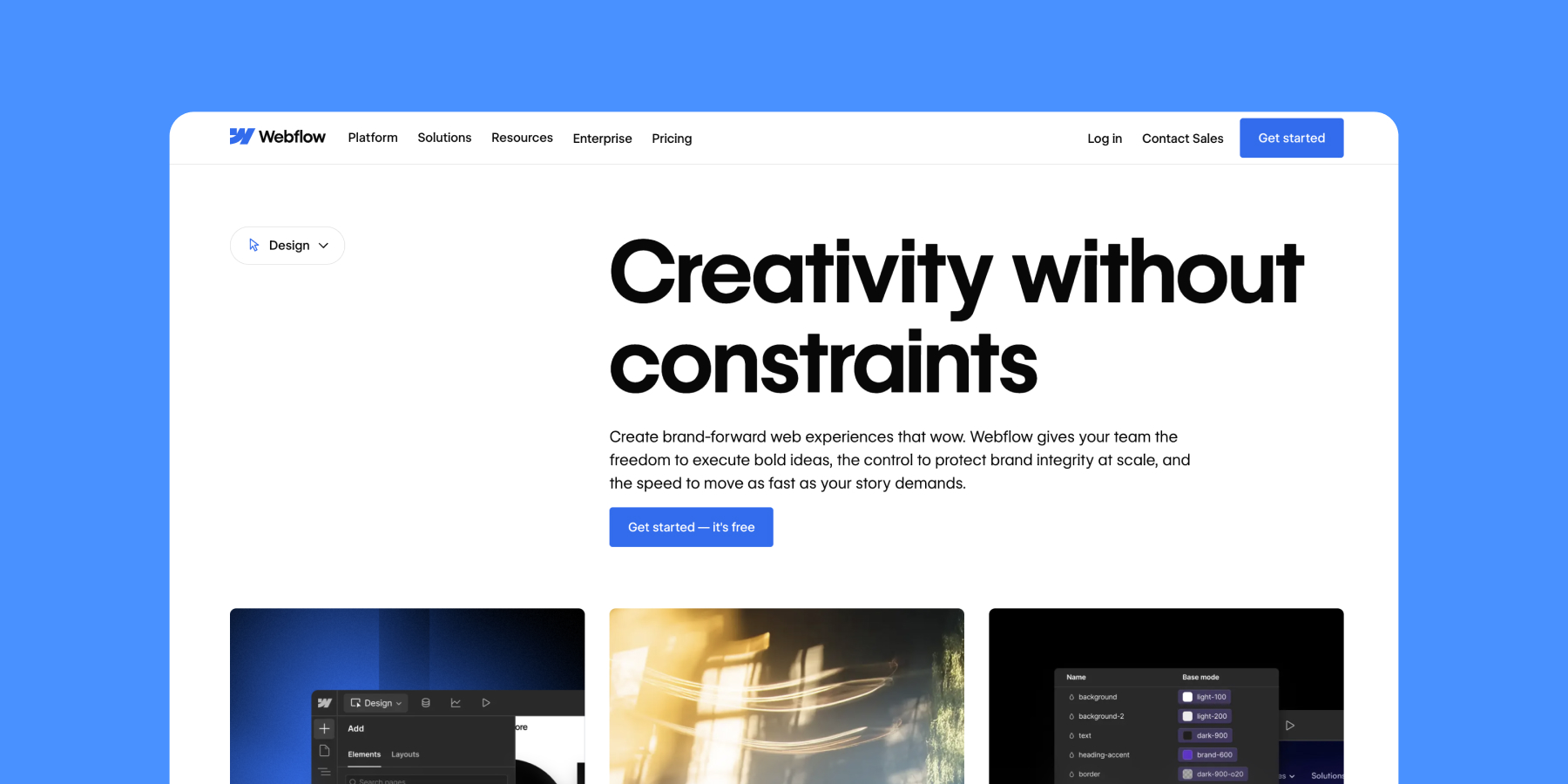
How Webflow decoupled launches from deployments

3.9M
45
Webflow is the leading AI-native web experience platform that empowers marketers, designers, and developers to visually build, manage, and optimize stunning websites that deliver enterprise-grade performance and AI-driven personalized experiences.
For Webflow, data-informed iteration has been core from the start. As the product and team scaled, the company sought a dependable, self-serve way to manage rollouts, learn from experiments, and ship at pace without trading off stability.
Life before Statsig: Homegrown tools that were hard to scale
Earlier in Webflow’s growth, homegrown systems powered speed, before scale became the challenge. Years before Statsig, Webflow ran on three independent homegrown systems: a beta-membership gate, an app-settings mechanism similar to dynamic configs, and a growth-team-centric experiment framework. Each delivered a thin sliver of feature-flagging or experimentation, but none added up to a complete, company-wide platform with full functionality.
Because of those limitations, percentage rollouts were often hand-coded per feature, so behavior varied by team and consistency was hard to maintain. Launches depended on deployments: a single JSON blob acted as the source of truth, and shipping meant removing gate checks and redeploying. Environments drifted across local, staging, and production with no simple promotion workflow or shared visibility, so teams often lacked clear visibility on how to reach the right state. And beta allow lists swelled into the thousands, turning “is this customer in?” into database lookups instead of a quick check in a purpose-built UI.
Finding Statsig
Webflow began evaluating several third-party vendors after hitting the limits of its internal tools. Positive word of mouth from former colleagues, including teams who had used Statsig at scale, helped put it on the shortlist.
Statsig stood out for developer ergonomics, including a clean SDK and intuitive Console, and for responsive guidance during a hands-on prototype spanning custom server side rendering (SSR)and Next.js applications.The collaboration moved quickly: questions were resolved, edge cases addressed, and the implementation path became clear.

Emerson Yu
Putting Statsig to work
Today, 45 teams across Webflow’s R&D organization use Statsig. Engineers are the primary operators, but PMs, designers, and both customer and technical support teams are active as well, with numerous users in the Console. As adoption has grown, Statsig has become the common control plane for shipping, testing, and runtime configuration across the stack.
Feature flagging:
Statsig is the default path to production. Every new feature ships behind a flag, enabling phased rollouts, partner and beta access, targeted exposure, and fast rollback. At Webflow’s scale, Statsig evaluates about 3.9 million gate checks per day. Phased rollouts are observable and low-risk, and big announcements can be coordinated down to the hour without redeploys, replacing high-coordination launch trains with calm, auditable controls. The team is also working toward standardized rollout patterns with alerting and guardrails, and is addressing hygiene across roughly 150 active flags, including a program to clean up stale flags.
Experimentation:
Building on that release foundation, the growth org completed its migration from the legacy A/B framework, and as of November 2024, nearly all experiments run on Statsig. The growth team now runs experiments in Statsig and is exploring deeper use of Statsig’s setup and scorecards to bring exposure and analysis closer together—aiming to shorten the loop from hypothesis to readout and reduce bespoke pipelines over time.
Dynamic configs:
Webflow manages about 90 configs to change runtime behavior without code changes. Teams use them for practical cases like scheduled content updates, locale targeting, observability tuning such as cohort-specific sampling, and plan or segment limits for CMS customers. Moving from large ID allowlists to identity-based targeting by attributes like plan, cohort, and region reduced operational toil, improved auditability, and lets non-engineers make governed adjustments in the Console with clear ownership and history.
Session Replay:
Webflow has also adopted Statsig for Session Replay to tie recordings to specific flags and experiments, which makes it straightforward to watch cohorts under active development and study the impact of changes within the same control plane. All use of Session Replay complies with Webflow’s privacy and data-handling standards.

Emerson Yu
Faster launches, lower risk, less friction
With Statsig, Webflow turned feature exposure into a product surface rather than a deployment chore. Launches are now phased and observable, timed releases no longer require redeploys, and kill switches make rollback routine, not exceptional. The result is less coordination overhead, fewer last-mile errors, and calmer launch days. Teams called out conference launches in particular as materially less stressful, since features can be enabled or rolled back with a button rather than a new deploy.

Emerson Yu
At the same time, Webflow consolidated three legacy tools into one platform and broadened access across teams. The growth org completed its migration, so nearly all experiments run on Statsig, and ~90 dynamic configs handle targeted runtime changes without code edits. A major cultural shift replaced sprawling ID allowlists with identity-based targeting, reducing overhead for engineers and support. And with roughly ~150 active flags at any given time, Webflow is running an ongoing cleanup effort, including early automation to identify and remove stale flags as usage scales.
The road ahead with Statsig
Webflow plans to deepen how teams work in Statsig beyond rollouts. They’re exploring bringing more analysis into Statsig for a cleaner, self-serve decision loop, are planning to explore per-user/per-project flag history to speed customer support, and want richer signals in Session Replay to make long sessions easier to mine. Operational hygiene remains a focus too, with continued stale-flag cleanup and automation over time.
Using Statsig for observability is another top priority. The near-term plan is to route a small set of golden metrics from Webflow’s existing stack into Statsig to enable near-real-time alerts during percentage rollouts and tie signals to specific flags before full production exposure.
About Webflow
Webflow is an AI-powered web experience platform that lets teams design, build, and launch production-grade websites and web applications without writing backend code. Combining a powerful design canvas with hosting, CMS, and collaboration features, Webflow helps design, marketing, and developer teams ship digital experiences faster—from concept to live URL.